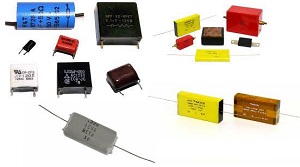Passive Components Products:
Paper Dielectric Capacitors
 Paper dielectric capacitors, also known as paper capacitors, are a type of capacitor that uses paper as the dielectric material. The dielectric is the insulating material between the capacitor's plates, and it plays a crucial role in the capacitor's performance. Paper capacitor is a capacitor that uses paper as the dielectric to store electric charge. It consists of aluminum sheets and paper sheets. The paper sheet is covered or soaked with oil or wax to protect it from outside harmful environment.
Paper dielectric capacitors, also known as paper capacitors, are a type of capacitor that uses paper as the dielectric material. The dielectric is the insulating material between the capacitor's plates, and it plays a crucial role in the capacitor's performance. Paper capacitor is a capacitor that uses paper as the dielectric to store electric charge. It consists of aluminum sheets and paper sheets. The paper sheet is covered or soaked with oil or wax to protect it from outside harmful environment.
The structure of paper capacitor is similar to other capacitors, such as plastic capacitors. The only difference between the other capacitors and paper capacitors is that the dielectric chosen is paper. Paper capacitors are also called fixed capacitors, in which paper is used as a dielectric, which stores energy in the form of an electric field.
-
Dielectric Material: The dielectric material in paper capacitors is typically a high-grade paper impregnated with oil or wax. This impregnation process enhances the dielectric properties of the paper, providing better insulation and increasing the capacitor's performance.
A paper capacitor is made up of two metallic plates with a dielectric material paper between them. It has positive and negative plates. When a small amount of electric charge is applied over the plates, the positive charge is attracted to one plate and a negative charge is attracted to another plate. This electrical energy is stored in the form of the electrical field. This stored electrical energy is used by the discharging of a capacitor. These are available in the range of 500pF to 50nF. These offer high leakage currents. Paper capacitors are the fixed type of capacitors that means these capacitors provides fixed capacitance (capacitance means ability to hold or store electric charge). In other words, the paper capacitor is a type of fixed capacitor that stores fixed amount of electric charge. -
Construction: Paper capacitors are usually constructed with alternating layers of metal foil and the impregnated paper dielectric. The layers are tightly wound or stacked to form the capacitor element. The entire assembly is then enclosed in a protective outer covering.
-
Capacitance Values: Paper capacitors can offer a wide range of capacitance values depending on the specific application requirements. The capacitance is determined by factors such as the area of the plates, the dielectric constant of the paper, and the distance between the plates.
-
Applications: Paper capacitors were widely used in electronic circuits, especially in the mid-20th century. They were commonly found in power supplies, coupling and decoupling circuits, audio equipment, and radio-frequency applications. However, due to advancements in capacitor technology, paper capacitors have been largely replaced by more modern and efficient capacitor types in many applications.
-
Advantages:
- High Voltage Ratings: Paper capacitors can handle relatively high voltage levels.
- Self-Healing: In the event of a breakdown, the impregnated dielectric can often "self-heal" by forming a carbonized path, reducing the risk of catastrophic failure.
-
Disadvantages:
- Size and Weight: Paper capacitors tend to be larger and heavier compared to some modern capacitor types with higher energy density.
- Limited Frequency Response: They may not perform well at higher frequencies compared to more modern capacitors.
IBS Electronics offers first-rate service and quality to deliver industry leading, high performance capacitance solutions to its customers around the world. IBS Electronics offers an extensive line of surface-mount and through-hole capacitor technologies used both in commercial and military applications across tantalum, ceramic, aluminum, film and paper dielectrics.
In addition to our franchise lines we actively stock and order parts from the following manufacturers:
- ASC Capacitors*
- Arcotronics
- Cal-Chip*
- Capax*
- Cera-Mite*
- CDE
- Faratronic*
- Fenghua*
- Ge / Genteq*
- HolyStone*
- Illinois Capacitor*
- Johanson*
- Koa*
- Maida*
- Meritek*
- Murata
- Nemco*
- Novacap*
- RG Allen*
- Stelco*
- Walsin*
- Wima*
- ASC
- AVX
- Arcotronics
- BC Components
- Beyschlag
- Cal Chip
- Cera-Mite
- Dale
- Draloric
- Epcos
- Electrocube
- Elna
- Evox/Rifa
- Fenghua
- Hilton
- Hitachi
- IBS Capacitor
- Illinois Capacitors
- ITT Components
- jb Capacitors*
- Johanson Dielectrics
- Johanson Mfg
- Kemet
- Koa
- Mallory *
- Matsuo
- Meritek
- Multicomp*
- Nemco
- NIC Components
- Nichicon America
- Nissei
- Novacap
- Panasonic Capacitors
- Roederstein
- Rohm
- Rubycon
- RG Allen
- Samwha
- Sanyo
- Sfernice
- Siemens
- Sincera*
- Sprague
- Stelco
- Syfer
- TDK
- Teapo
- Tacate
- Thomson-CSF*
- TPC
- United Chemi-Con
- Voltronics*
- Vishay
- Vitramon
- Wima
- Yageo
- Kamaya*
- jb Capacitors*
- ECi Capacitors*
- Soshin*
- Nesscap